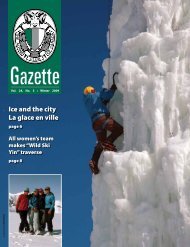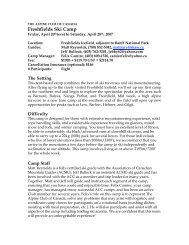A Passion for the Mountains - The Alpine Club of Canada
A Passion for the Mountains - The Alpine Club of Canada
A Passion for the Mountains - The Alpine Club of Canada
You also want an ePaper? Increase the reach of your titles
YUMPU automatically turns print PDFs into web optimized ePapers that Google loves.
Beef up that Belay!<br />
by Murray T<strong>of</strong>t<br />
<strong>The</strong><br />
sport climbing mantra, “If<br />
you’re not fl ying, you’re not<br />
trying,” has accepted and expected falling<br />
as normal behavior in rock climbing.<br />
<strong>The</strong> widespread growth <strong>of</strong> bolted climbs<br />
has defi nitely contributed to <strong>the</strong> rise in<br />
physical achievement and creativity since<br />
<strong>the</strong> consequences <strong>of</strong> falling have been<br />
minimized.<br />
If and when <strong>the</strong> next step is taken<br />
and climbers move from <strong>the</strong> cleaned and<br />
prepared playground <strong>of</strong> bolted climbs to<br />
jump onto more committing multi-pitch<br />
alpine rock, a corresponding skill set must<br />
widen and deepen to<br />
keep things safe. And<br />
<strong>the</strong> bottom line <strong>of</strong> safety<br />
here is <strong>the</strong> belay. Thirty<br />
years ago, refl ecting<br />
on his Yosemite wall<br />
climbs, Tom Frost told<br />
me he wasn’t afraid<br />
<strong>of</strong> doing anything up<br />
<strong>the</strong>re, as long as he knew<br />
that <strong>the</strong> belay WOULD<br />
NOT FAIL.<br />
Since <strong>the</strong>n, I’ve been<br />
party to, or witness to,<br />
or chatted with, victims <strong>of</strong> long falls on<br />
multi-pitch alpine rock. <strong>The</strong> natural fi rst<br />
reaction is to focus on <strong>the</strong> state <strong>of</strong> repair <strong>of</strong><br />
<strong>the</strong> leader. However, in cases where lead pro<br />
had failed, <strong>the</strong> impact <strong>for</strong>ce that came on<br />
<strong>the</strong> belayer was really quite shocking. <strong>The</strong><br />
belayers suffered serious injuries as well as<br />
<strong>the</strong> leader. To hold a leader fall <strong>of</strong> any length<br />
directly on <strong>the</strong> harness ei<strong>the</strong>r be<strong>for</strong>e <strong>the</strong><br />
leader can get gear in, or in <strong>the</strong> case <strong>of</strong> failed<br />
protection, is a scenario with ugly potential<br />
<strong>for</strong> <strong>the</strong> belayer. <strong>The</strong>re is great potential <strong>for</strong><br />
injury to <strong>the</strong> lower back or at least buckling<br />
<strong>of</strong> <strong>the</strong> belayer’s legs, which could contribute<br />
to a failed belay. Additional injuries range<br />
from <strong>the</strong> belayer suffering from major body<br />
hammering and bruising, to having seriously<br />
burned hands, to being concussed into a<br />
state <strong>of</strong> dysfunction and unable to respond<br />
adequately to <strong>the</strong> evolving situation.<br />
Since standard practice in North America<br />
is to belay <strong>of</strong>f <strong>the</strong> harness ra<strong>the</strong>r than<br />
directly from a bomb-pro<strong>of</strong> fi xed anchor<br />
ring (some areas in Europe), it is vital that<br />
we enhance <strong>the</strong> belay to alleviate impact<br />
<strong>for</strong>ces on <strong>the</strong> body. We can do this easily<br />
by redirecting <strong>the</strong> active rope to <strong>the</strong> climber<br />
through an independent, bombpro<strong>of</strong><br />
placement. <strong>The</strong> most perfect arrangement<br />
would have this high and slightly <strong>of</strong>f to <strong>the</strong><br />
active rope side within com<strong>for</strong>table reach<br />
<strong>of</strong> <strong>the</strong> belay anchors. By doing so we create<br />
similar rope mechanics to that which we use<br />
in top-roping situations. Conventionally,<br />
however, we see most climbers resorting to<br />
using one <strong>of</strong> <strong>the</strong> higher pieces <strong>of</strong> <strong>the</strong> belay<br />
<strong>for</strong> this action.<br />
In ei<strong>the</strong>r case, when we re-direct <strong>the</strong><br />
rope this way, we incorporate in <strong>the</strong> belay<br />
system a critical turnaround that <strong>the</strong> live<br />
rope runs over. <strong>The</strong> more acute <strong>the</strong> angle <strong>of</strong><br />
this bend, <strong>the</strong> more friction, and <strong>the</strong> s<strong>of</strong>ter<br />
<strong>the</strong> ‘catch’ <strong>for</strong> <strong>the</strong> belayer when a fall occurs.<br />
At <strong>the</strong> same time, <strong>the</strong> belayer’s braking<br />
hand pulls down, a biomechanically and<br />
physically more effective position to create<br />
braking <strong>for</strong>ces.<br />
In this arrangement it is vital that extra<br />
‘low’ gear is placed in <strong>the</strong> belay anchor<br />
confi guration and cinched tightly to <strong>the</strong><br />
higher piece(s) to prevent <strong>the</strong>m from<br />
lifting. This ‘pieces in opposition’ concept<br />
is especially <strong>the</strong> case if spring-loaded<br />
camming devices are used. <strong>The</strong>y should not<br />
be allowed to shift or walk when load comes<br />
on <strong>the</strong> focal point (attachment point) <strong>of</strong> <strong>the</strong><br />
belay.<br />
When swinging leads, <strong>the</strong> redirect<br />
becomes <strong>the</strong> fi rst runner as <strong>the</strong> second moves<br />
into <strong>the</strong> lead and eliminates <strong>the</strong> possibility<br />
<strong>of</strong> a ‘fall factor 2’<br />
on <strong>the</strong> belayer (<strong>the</strong><br />
worst case scenario).<br />
Now it becomes<br />
<strong>the</strong> responsibility <strong>of</strong><br />
<strong>the</strong> leader to take<br />
advantage <strong>of</strong> obvious<br />
gear placements<br />
within <strong>the</strong> fi rst few<br />
meters <strong>of</strong> leaving<br />
<strong>the</strong> belay. This can<br />
be as important on<br />
easy rock as it is on<br />
higher angle terrain,<br />
especially in loose s<strong>of</strong>t-rock climbing areas<br />
(Rockies). Falling hazards from above, wet<br />
rock and <strong>the</strong> potential <strong>for</strong> holds breaking,<br />
increase <strong>the</strong> risk <strong>for</strong> leader falls. If a hold<br />
breaks early in <strong>the</strong> pitch, on easy terrain<br />
without intermediate protection, <strong>the</strong> full<br />
<strong>for</strong>ce <strong>of</strong> <strong>the</strong> fall would come on <strong>the</strong> belayer.<br />
In <strong>the</strong> aftermath, both parties want <strong>the</strong><br />
belayer’s hands to be functional and able to<br />
deal with <strong>the</strong> subsequent response; to ei<strong>the</strong>r<br />
continue belaying, or lowering, or creating<br />
a hoisting system. We must strive to protect<br />
those hands with creative anchor rigs.<br />
Murray T<strong>of</strong>t sits on <strong>the</strong> <strong>Alpine</strong> <strong>Club</strong> <strong>of</strong><br />
<strong>Canada</strong>’s Safety Committee.<br />
<strong>Alpine</strong> <strong>Club</strong> <strong>of</strong> <strong>Canada</strong> ● Gazette ● Summer 2003 9

















